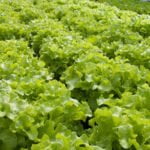Pressure treated wood is a popular option for building raised beds in vegetable gardens due to its durability and resistance to rot and pests. However, there are concerns about the potential risks it may pose to the health of the plants and those consuming them. In this section, we will delve into what pressure treated wood is, how it’s made, and the factors to consider when using it in your vegetable garden.
Pressure treated wood undergoes a process where preservatives are forced into the wood under high pressure to enhance its resistance to decay and insect infestation. These preservatives can include chemicals such as copper, chromium, and arsenic, which have raised concerns about their potential leaching into the soil and being absorbed by plants. As a result, many gardeners are seeking alternative construction materials for their raised beds to ensure the safety of their produce.
In this section, we will explore the various alternatives to using pressure treated wood for building raised beds in vegetable gardens. From natural untreated woods to composite materials, there are options available that offer both durability and peace of mind when it comes to potential risks to plant health and food safety. Understanding these alternatives can help you make an informed decision for your vegetable garden’s construction materials.
The Potential Risks of Using Pressure Treated Wood in Vegetable Gardens
Pressure treated wood is a popular choice for building raised beds in vegetable gardens due to its durability and resistance to rot. However, there are potential risks associated with using this type of wood in close proximity to edible plants.
One major concern is the leaching of harmful chemicals such as arsenic, chromium, and copper from the treated wood into the soil, which can then be taken up by the plants. This can result in these toxic substances ending up in the vegetables grown in the garden, posing a risk to human health.
Another risk is the environmental impact of pressure treated wood. When it reaches the end of its lifespan, it can release harmful chemicals into the surrounding soil and water, further impacting the ecosystem.
Given these potential risks, many gardeners are seeking alternatives to pressure treated wood for their raised beds. Using natural rot-resistant woods such as cedar or redwood can provide a safer option for building raised beds in vegetable gardens.
Despite the risks associated with pressure treated wood, there are best practices that can help minimize these concerns and ensure safer use in vegetable gardens. Properly sealing the wood with an appropriate sealant can help reduce chemical leaching and prolong its lifespan.
| Concern | Risks |
|---|---|
| Leaching of Harmful Chemicals | Potential exposure to arsenic, chromium, and copper |
| Environmental Impact | Harmful chemicals released into soil and water at end of lifespan |
| Safer Alternatives | Natural rot-resistant woods such as cedar or redwood |
Alternatives to Pressure Treated Wood for Building Raised Beds
When it comes to building raised beds for vegetable gardens, many people turn to pressure treated wood for its durability and resistance to decay. However, there are concerns about the potential risks of using pressure treated wood in close proximity to edible plants. This has led gardeners to seek out alternative materials for constructing their raised beds.
One of the main concerns about using pressure treated wood in vegetable gardens is the potential for chemicals used in the treatment process to leach into the soil and be absorbed by the plants. The most common chemical used in pressure treated wood is chromated copper arsenate (CCA), which contains arsenic, a known carcinogen.
While manufacturers have transitioned to using other treatment chemicals, such as alkaline copper quaternary (ACQ) or copper azole, these substances still raise some health and environmental concerns.
Given these concerns, gardeners are exploring alternative materials for constructing their raised beds. Some popular alternatives include cedar, redwood, composite lumber made from recycled materials, and untreated pine. These materials are naturally resistant to decay and do not contain chemical treatments that could potentially harm the soil or plants. Additionally, utilizing recycled materials aligns with environmentally friendly gardening practices.
It is important for gardeners to make an informed decision when choosing construction materials for their vegetable gardens. By considering the potential risks of using pressure treated wood and exploring alternative options, gardeners can create a safe and sustainable environment for growing their produce. Making careful choices about construction materials can contribute to the overall health and success of a vegetable garden.
| Alternative Material | Benefits |
|---|---|
| Cedar | Naturally resistant to decay; chemical-free |
| Redwood | Durable; naturally resistant to rotting |
| Composite Lumber | Made from recycled materials; low maintenance |
Best Practices for Using Pressure Treated Wood in Vegetable Gardens
When it comes to using pressure treated wood in vegetable gardens, it’s important to follow best practices to ensure the safety of the plants and the people consuming them. Pressure treated wood is a popular choice for building raised beds and other garden structures due to its resistance to rot and insects. However, it’s crucial to understand how to use it properly in order to minimize any potential risks.
Choosing the Right Type of Pressure Treated Wood
Not all pressure treated wood is created equal, so it’s essential to select the right type for your vegetable garden. Look for wood that is treated with safer alternatives such as alkaline copper quaternary (ACQ) or copper azole (CA) rather than chromated copper arsenate (CCA), which can leach harmful chemicals into the soil.
Protecting Your Garden
To prevent direct contact between the pressure treated wood and the soil where your vegetables are growing, consider lining the interior of your raised beds with heavy-duty plastic sheeting or using a barrier fabric. This will create a physical barrier that prevents any potential toxins from leaching into the soil.
Maintaining and Sealing
Regularly inspect your pressure treated wood structures for any signs of wear or damage, such as cracks or splintering. To extend the longevity of your wood, consider sealing it with an appropriate non-toxic sealant or stain that is safe for vegetable gardens. This will help protect both the wood and your plants from any potential leaching of chemicals over time.
By following these best practices, you can safely use pressure treated wood in your vegetable garden while minimizing any potential risks associated with its use. It’s important to stay informed about the latest research and recommendations regarding pressure treated wood in order to make well-informed decisions for your garden construction materials.
How to Safely Maintain Pressure Treated Wood for Longevity
Pressure treated wood is a popular choice for building raised beds in vegetable gardens due to its resistance to decay and insects. However, it’s important to properly maintain pressure treated wood to ensure its longevity and minimize any potential risks to your vegetable garden.
To safely maintain pressure treated wood for longevity, consider the following best practices:
1. Regular Inspection: Periodically inspect your pressure treated wood for any signs of damage or decay. Look for cracks, warping, or discoloration that may indicate the need for maintenance or repairs.
2. Cleaning: Use a mild detergent and water to clean the surface of pressure treated wood. Avoid using harsh chemicals or cleaners that can potentially leach into the soil and affect your vegetables.
3. Sealant Application: Apply a water-based sealant or stain specifically designed for use on pressure treated wood. This can help protect the wood from moisture and UV damage, extending its lifespan in your vegetable garden.
4. Avoid Direct Contact with Soil: To minimize any potential leaching of chemicals from the pressure treated wood into the soil, consider lining the interior of raised beds with a thick plastic sheeting or landscape fabric before adding soil.
5. Regular Maintenance: Keep an eye on the condition of your pressure treated wood over time and perform regular maintenance as needed to ensure its longevity in your vegetable garden.
By following these maintenance tips, you can safely use pressure treated wood in your vegetable garden while minimizing any potential risks associated with its use. With proper care, your raised beds constructed from pressure treated wood can provide a durable and long-lasting solution for growing healthy vegetables.
Environmental Impact of Using Pressure Treated Wood in Vegetable Gardens
Pressure treated wood is a popular choice for building raised beds in vegetable gardens due to its durability and resistance to decay. However, there are concerns about the environmental impact of using pressure treated wood, particularly in close proximity to edible plants. Here are some important considerations to keep in mind regarding the environmental impact of using pressure treated wood in vegetable gardens:
- Leaching of Chemicals: Pressure treated wood is infused with chemicals such as arsenic, chromium, and copper to enhance its rot resistance. Over time, these chemicals can leach into the soil, which may then be absorbed by vegetables and other plants.
- Soil Contamination: The accumulation of chemical preservatives from pressure treated wood can lead to soil contamination, affecting not only the immediate garden area but also nearby ecosystems if runoff occurs.
- Long-Term Effects: While pressure treated wood may have a longer lifespan than untreated wood, its environmental impact over time should be carefully considered. It’s important to weigh the potential benefits against the risks associated with using this type of material in vegetable gardens.
Given these concerns, many gardeners are exploring alternative materials for constructing raised beds in their vegetable gardens. Untreated natural woods such as cedar or redwood are popular choices due to their natural resistance to decay without the use of chemical preservatives.
Additionally, utilizing recycled composite materials or untreated metal can provide durable and eco-friendly options for creating raised beds. By carefully considering the environmental impact of construction materials in vegetable gardens, gardeners can make informed decisions that promote both plant health and sustainability.
Case Studies
Success Stories
In many cases, gardeners have successfully used pressure treated wood in their vegetable gardens without experiencing any negative effects on their produce or their health. One key factor in these success stories is the use of a protective barrier between the pressure treated wood and the soil. By lining the inside of raised beds with heavy plastic, gardeners can prevent the chemicals from leaching into the soil and potentially harming their plants.
Another important aspect of these success stories is regular monitoring and maintenance of the pressure treated wood. Gardeners who have reported positive experiences with using this material often mention that they regularly inspect their raised beds for signs of deterioration or chemical leaching. By addressing any issues promptly, they are able to maintain a safe growing environment for their vegetables.
Challenges Faced
On the other hand, some gardeners have faced challenges when using pressure treated wood in their vegetable gardens. One common issue is the reluctance of some plants to thrive in this environment. Certain delicate or sensitive vegetables may not perform as well when grown in raised beds made from pressure treated wood, even with protective measures in place.
Additionally, there have been cases where gardeners notice discoloration or unusual growth patterns in their vegetables, which they suspect may be linked to the use of pressure treated wood. While it can be difficult to definitively prove causation in these situations, some individuals choose to err on the side of caution and seek alternative materials for their raised beds.
Lessons Learned
Overall, the case studies of using pressure treated wood in vegetable gardens highlight the importance of careful consideration and vigilance when making choices about construction materials. Success can be achieved through proactive measures such as using barriers and conducting regular inspections, but it’s also crucial to acknowledge and address any challenges that may arise. Gardening enthusiasts can learn from both positive and negative experiences to make informed decisions for their own vegetable gardens.
Expert Tips and Recommendations for Using Pressure Treated Wood in Vegetable Gardens
Pressure treated wood is a popular choice for constructing raised beds in vegetable gardens due to its durability and resistance to rot and pests. However, there are potential risks associated with using pressure treated wood in close proximity to edible plants. To ensure the safety of your vegetable garden, it is important to follow expert tips and recommendations when using pressure treated wood.
When selecting pressure treated wood for your vegetable garden, look for products that are labeled as “safe for use around edible plants.” These types of pressure treated wood are specially formulated to minimize the leaching of harmful chemicals into the soil. Additionally, consider using a sealant or barrier, such as a plastic liner, between the pressure treated wood and the soil to further reduce the risk of chemical leaching.
It is also recommended to avoid using pressure treated wood in direct contact with the soil or where it may come into contact with edible plant parts. Instead, consider using alternative materials for constructing raised beds, such as naturally rot-resistant woods like cedar or redwood, composite lumber made from recycled materials, or untreated hardwoods. These alternatives can provide a safer option for building raised beds while still offering durability and longevity.
In addition to carefully selecting and positioning pressure treated wood in your vegetable garden, it is crucial to regularly monitor and maintain the material. Inspect the wood for any signs of deterioration or chemical leaching, and promptly address any issues that arise. By taking these precautions and following expert recommendations, you can use pressure treated wood in your vegetable garden while minimizing potential risks to your plants and soil.
Conclusion
In conclusion, it is important for vegetable gardeners to carefully consider the use of pressure treated wood in their construction materials. While pressure treated wood offers durability and longevity, it also poses potential risks to the health of the plants and those consuming the produce. Understanding the process of how pressure treated wood is made and the associated environmental impact is crucial in making an informed decision.
For those who are concerned about the potential risks of using pressure treated wood in their vegetable gardens, there are alternatives available for building raised beds. Materials such as cedar, redwood, or composite lumber can provide a safe and sustainable option for constructing garden beds without the worry of harmful chemicals leaching into the soil.
Ultimately, it is important for gardeners to weigh the pros and cons of using pressure treated wood in their vegetable gardens. Following best practices for its use and maintenance can help minimize any potential risks while maximizing its benefits for longevity. By staying informed and considering all available options, gardeners can make a decision that best suits their needs while ensuring a healthy and thriving vegetable garden.
Frequently Asked Questions
Is It OK to Use Pressure Treated Wood in a Vegetable Garden?
Using pressure-treated wood in a vegetable garden can be a concern due to the chemicals used to treat the wood. These chemicals can potentially leach into the soil and then into the plants, posing a risk to human health.
Is Home Depot Pressure-Treated Lumber Safe for Vegetable Gardens?
Home Depot’s pressure-treated lumber is typically treated with chemicals that may not be safe for use in vegetable gardens. It’s important to look for alternative options such as cedar or redwood that are naturally resistant to decay without harmful chemicals leaching into the soil.
What Wood Should Not Be Used in a Raised Garden Bed?
Some woods that should not be used in raised garden beds include woods treated with creosote, penta, or other toxic compounds. These chemicals can leach into the soil and potentially harm plants and ultimately pose a risk to those consuming the vegetables grown in them.

If you’re looking to get into vegetable gardening, or are just looking for some tips on how to make your current garden better, then you’ve come to the right place! My name is Ethel and I have been gardening for years. In this blog, I’m going to share with you some of my best tips on how to create a successful vegetable garden.





